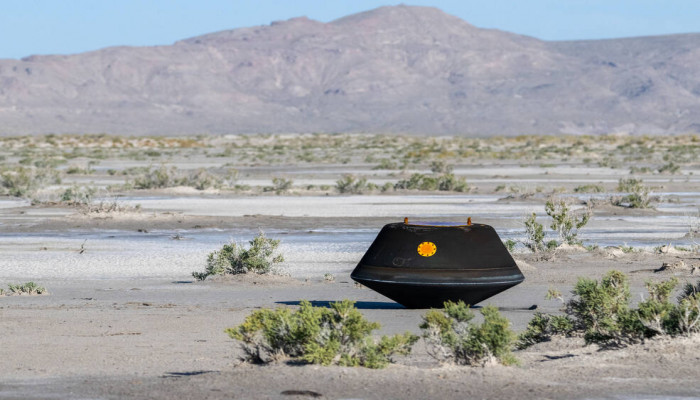NASA's first asteroid samples land on Earth after release from spacecraft
- In Reports
- 11:06 PM, Sep 25, 2023
- Myind Staff
On September 24, after a seven-year journey, NASA's first asteroid samples fetched from deep space parachuted into the Utah desert.
After traveling for over 4 billion miles (6.2 billion kilometers) to reach Bennu and then make the journey home, the OSIRIS-REx probe released its sample return capsule this morning while it was about 63,000 miles (101,000 km) above Earth. The small capsule landed four hours later on a remote expanse of military land, as the mothership set off after another asteroid. The capsule contains some 250 grams (8.8 ounces) of rocks and other material from Bennu, material that could help answer some of the scientists' most burning questions about the origins of life on Earth and the early days of our solar system.
"Touchdown for science!" said Jim Garvin, chief scientist of NASA's Goddard Space Flight Centre, from the landing site during a live broadcast. "For the first time in history, we brought goodies back home from this kind of object. This is so huge and we're all breathing a big sigh of relief."
As it plummeted through Earth's atmosphere, the OSIRIS-REx spacecraft endured heatshield temperatures of up to 5,300 degrees Fahrenheit (2,900 degrees Celsius) and speeds of up to 27,000 mph (43,450 km/h).
At a height of nearly 20,000 feet, four times higher than anticipated at 5,000 feet, the capsule opened its main parachute, yet it appeared to land without mishap. In the post-landing conference, representatives from NASA and Lockheed Martin Space Systems, which constructed OSIRIS-REx, assured reporters that the drogue chute was certainly deployed; it was just not visible on the cameras observing the descent.
As the sample return capsule floated down to the desert floor of the U.S. Department of Defense's Utah Test and Training Range, the capsule cooled down enough so that U.S. Air Force personnel could approach after locating it.
Once on the ground, the capsule and surrounding area were examined to make sure it was safe for OSIRIS-REx team members and recovery personnel to approach and examine the capsule. An early examination by recovery teams found that the capsule was intact and suffered no breaches during landing.
The Bennu sample will be transported in its unopened canister by aircraft to NASA’s Johnson Space Centre in Houston on Monday, Sept. 25. Curation scientists there will disassemble the canister, extract and weigh the sample, create an inventory of the rocks and dust, and, over time, distribute pieces of Bennu to scientists worldwide. The facility already contains the hundreds of kilograms (kilos) of moon rocks that the Apollo astronauts collected.
The capsule is thought to contain at least a cup of debris from the carbon-rich asteroid known as Bennu, but the precise amount won't be known until the container is opened in a few days. When the spacecraft picked up too much material, the lid of the container jammed during collection three years ago, causing some of it to leak and float away.
Japan, the only other country to bring back samples, gathered about a teaspoon during a pair of asteroid missions.
The sample will then be split among several research organizations and international space organisations. 70% of the material will be retained by NASA and kept at JSC for further analysis. Over 200 scientists at 35 various facilities will each receive 25% more. A further 0.5% will go to the Japan Aerospace Exploration Agency (JAXA), and 4% will go to the Canadian Space Agency.
The pebbles and dust delivered Sunday represent the biggest haul from beyond the moon. Preserved building blocks from the dawn of our solar system, the samples will help scientists better understand how Earth and life formed, providing “an extraordinary glimpse” of 4.5 billion years ago, said NASA Administrator Bill Nelson.
In 2016, the mothership, Osiris-Rex, rocketed away on a $1 billion mission. It reached Bennu two years later and, using a long stick vacuum, grabbed rubble from the small roundish space rock in 2020. The spaceship travelled 4 billion miles (6.2 billion km) before it came back.
Currently orbiting the sun 50 million miles (81 million kilometres) from Earth, Bennu is about one-third of a mile (one-half of a kilometre) across, roughly the size of the Empire State Building but shaped like a spinning top. It’s believed to be the broken fragment of a much larger asteroid.
Osiris-Rex discovered Bennu to be a large debris field full of boulders and craters during a two-year survey. The asteroid's surface was so flimsy that the vacuum arm of the spacecraft dipped a foot or two (0.5 meters) into the body, collecting more material than expected.
These close-up observations may come in handy late next century. Bennu is expected to come dangerously close to Earth in 2182 — possibly close enough to hit. Dante Lauretta, principal investigator of the OSIRIS-REx mission, asserts that any effort to divert asteroids will benefit from the information collected by Osiris-Rex.
Osiris-Rex is already chasing after the asteroid Apophis and will reach it in 2029.
This was NASA's third deep space robotic mission sample return. In 2004, the Genesis spacecraft released solar wind fragments, but the samples were damaged when the parachute malfunctioned and the capsule crashed into the earth. In 2006, the Stardust spacecraft delivered comet dust with success.
Image source: NASA







Comments